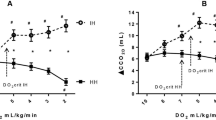Summary
In 25 experiments isolated canine brains perfused with blood from donor dogs were subjected to complete ischemias of 1, 5, 10, 20 and 30 min. The perfusion of the brain was performed from the internal maxillary arteries. The perfusion pressure was recorded in the circle of Willis. Cerebral blood flow and venous O2-saturation were monitored continuously. ArterialpO2,pCO2 and pH as well as brain temperature were kept constant. The ECoG before complete ischemia was not pathologically altered and the cerebral vasculature showed autoregulatory behaviour. The mean O2-availability was 8.1±1.4 ml/100g·min and the mean O2-consumption was 3.4±0.4 ml/100 g·min.
-
1.
All ischemias were followed by an increase of O2-availability due to reactive hyperemia. The excess O2-availability was correlated to the duration of complete oerebral ischemia.
-
2.
After the 5 and 10 min ischemias a significant increase of cerebral O2-consumption was found which lasted up to the 4th min of reperfusion.
-
3.
After the prolonged ischemias there was no longer any correlation between the O2-availability and the O2-consumption of the brain.
Similar content being viewed by others
References
Ames, A. III, Wright, L., Kowoda, M., Thurston, J. M., Majno, G.: Cerebral ischemia. II The No-Reflow Phenomenon. Amer. J. Path.52, 437–453 (1968).
Baez, S., Hershey, S. G., Rovenstine, E. A.: Vasotropic substances in blood in intestinal ischemic shock. Amer. J. Physiol.200, 1245–1250 (1961).
Bayliss, W. M.: On the local reaction of the arterial wall to changes of internal pressure. J. Physiol. (Lond.)28, 220–231 (1902).
Berne, R. M.: Cardiac nucleotides in hypoxia: role in regulation of coronary blood flow. Amer. J. Physiol.204, 317–322 (1963).
Betz, E., Kozak, R.: Der Einfluß der Wasserstoffionenkonzentration der Gehirnrinde auf die Regulation der corticalen Durchblutung. Pflügers Arch. ges. Physiol.293, 56–67 (1967).
Cantu, R. C., Ames, A. III.: Experimental prevention of cerebral vasculature obstruction produced by ischemia. J. Neurosurg.30, 50–54 (1969).
Chiang, J., Kowada, M., Ames, A., III, Wright, R. L., Majno, G.: Cerebral ischemia. III. Vascular changes. Amer. J. Path.52, 455–476 (1968).
Cohen, M. M.: The effect of anoxia on the chemistry and morphology of cerebral cortex slices in vitro. J. Neurochem.9, 337–344 (1962).
Cohen, P. J., Alexander, S. C., Smith, Th. C., Reivich, M., Wollman, H.: Effects of hypoxia and normocarbia on cerebral blood flow and metabolism in conscious man. J. appl. Physiol.23, 183–189 (1967).
Crawford, D. G., Fairchild, H. M., Guyton, A. C.: Oxygen lack as a possible cause of reactive hyperemia. Amer. J. Physiol.197, 613–616 (1959).
Deuticke, B., Gerlach, E.: Abbau freier Nucleotide in Herz, Skeletmuskel, Gehirn und Leber der Ratte bei Sauerstoffmangel. Pflügers Arch. ges. Physiol.292, 239–254 (1966).
Diemer, K.: Über die Sauerstoffdiffusion im Gehirn. II. Die Sauerstoffdiffusion bei O2-Mangelzuständen. Pflügers Arch. ges. Physiol.185, 109–118 (1965).
Ekström-Jodal, B.: On the relation between blood pressure and blood flow in the canine brain with particular regard to the mechanism responsible for cerebral blood flow autoregulation. Acta physiol. scand. Suppl.350, 1–28 (1970).
Folkow, B.: Intravascular pressure as a factor regulating the tone of the small blood vessels. Acta physiol. scand.17, 289–310 (1949).
Grunewald, W.: Digitale Simulation eines räumlichen Diffusionsmodelles der O2-Versorgung biologischer Gewebe. Pflügers Arch.309, 266–284 (1969).
Guyton, A. C., Ross, J. M., Carrier, O., Walker, J. M.: Evidence for tissue oxygen demand as the major factor causing autoregulation. Circulat. Res.14, 60–68 (1964).
Häggendal, E., Löfgren, J., Nilsson, N. J., Zwetnow, N. N.: Effects of varied cerebrospinal fluid pressure on cerebral blood flow in dogs. Acta physiol. scand.79, 262–271 (1970).
Hager, M.: Electron microscopic changes in brain tissue of Syrian Hamsters following acute hypoxia. Aerospace Med.31, 379–387 (1960).
Hills, C. P.: Ultrastructural changes in the capillary bed of the rat cerebral cortex in anoxic-ischemic lesions. Amer. J. Path.44, 531–551 (1964).
Hilton, S. M., Lewis, G. P.: Functional vasodilation in the submandibular salivary gland. Brit. med. Bull.13, 189–196 (1957).
Hirsch, H., Doose, E., Grote, G., Jarai, S., Kristen, H.: Über den Einfluß der Halsmarkdurchtrennung auf den cerebralen Sauerstoffverbrauch beim Hund in Barbituratnarkose. Pflügers Arch. ges. Physiol.271, 727–731 (1960).
—, Krenkel, W., Schneider, M., Schnellbächer, F.: Der Sauerstoffverbrauch des Warmblütergehirns bei Sauerstoffmangel durch Ischämie und der Mechanismus der Mangelwirkung. Pflügers Arch. ges. Physiol.261, 402–408 (1955).
Ingvar, D. H.: Correlation between cerebral function and cerebral blood flow and its disappearance following anoxia. In: Pharmakologie der lokalen Gehirndurchblutung. München: Dr. E. Barnaschewski 1969.
Kobold, E. E., Thal, A. P.: Quantitation and identification of vasoactive substances liberated during various types of experimental and clinical intestinal ischemia. Surg. Gynec. Obstet.117, 315–322 (1963).
Kogure, K., Scheinberg, P., Reinmuth, O. M., Fujishima, M., Busto, R.: Mechanisms of cerebral vasodilation in hypoxia. J. appl. Physiol.29, 223–229 (1970).
Merker, G.: Ultrastrukturveränderungen motorischer Vorderhornzellen des Kaninchens unter abgestufter Ischämie. Z. Zellforsch.95, 568–593 (1969).
Patterson, G. C.: The role of intravascular pressure in the causation of reactive hyperemia in the human forearm. Clin. Sci.15, 17–25 (1956).
Rapela, C. E., Green, H. D.: Autoregulation of canine cerebral blood flow. Circulat. Res.15, Suppl. 1, 205–212 (1964).
Thews, G.: Die Sauerstoffdiffusion im Gehirn. Pflügers Arch. ges. Physiol.271, 197–226 (1960).
Van Harreveld, A.: Changes in volume of cortical neuronal elements during asphyxiation. Amer. J. Physiol.191, 233–242 (1957).
Webster, H. de E., Ames, A.: Reversible and irreversible changes in the fine structure of nervous tissue during oxygen and glucose deprivation. J. Cell Biol.26, 885–909 (1965).
Yonce, L. R., Hamilton, W. F.: Oxygen consumption in skeletal muscle during reactive hyperemia. Amer. J. Physiol.197, 190–192 (1959).
Zimmer, R., Lang, R., Oberdörster, G.: Post-ischemic reactive hyperemia of the isolated perfused brain of the dog. Pflügers Arch.328, 332–343 (1971).
Author information
Authors and Affiliations
Additional information
Partially reported at the XXV International Congress of Physiological Sciences, Munich, 1971; Proceedings of the International Union of Physiological Sciences, Volume IX, 335 (1971).
Rights and permissions
About this article
Cite this article
Lang, R., Zimmer, R. & Oberdörster, G. Post-ischemic O2-availability and O2-consumption of the isolated perfused brain of the dog. Pflugers Arch. 334, 103–113 (1972). https://doi.org/10.1007/BF00586784
Received:
Issue Date:
DOI: https://doi.org/10.1007/BF00586784



